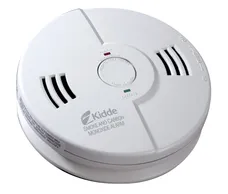Carbon Monoxide and Smoke Detectors
How To Prevent Carbon Monoxide Poisoning

Carbon Monoxide, a poisonous, colorless, odorless gas, is created from incompletely burned fuel and is the leading cause of accidental poisoning deaths in America.
- Have a yearly professional inspection of all of your home’s fuel burning appliances at the beginning of the heating seasons including furnaces, hot water heaters, gas ovens and stoves.
- Chimneys, flues and vents should also be inspected for leakage and blockage by creosote or debris. Have all vents to furnaces, water heaters or boilers checked to make sure they are not loose or disconnected.
- Make sure that your appliances have adequate ventilation. This includes gas water heaters, clothes dryers, space heaters and wood burning stoves.
- Never use charcoal grills in an enclosed space such as a home, garage, vehicle or tent and never bring live coals indoors after use. Never use charcoal grills as an indoor heat source.
- Never leave a car running in an attached garage even if the garage door is open. Install a carbon monoxide detector on the ceiling near each sleeping area. If your alarm sounds and you are feeling drowsy or dizzy, leave the house and call 911 from the neighbors house. Do not reenter the house.
Smoke detectors save lives.
They are the easiest, most cost-efficient way to alert your family of a developing fire. Working smoke alarms cut the risk of dying in a home fire by 50%, and that’s important, because a home fire starts every 83 seconds! The faster you know about a fire, the faster you can start moving your family outside. Before you choose your smoke alarms, consider how many you need, where you should install them, when to replace them and what unique features different smoke alarms have.
Where To Place
- Buy an approved smoke detector. Look for the UL Label.
- Install a smoke detector inside each bedroom and in the main corridor outside of each bedroom area.
- Install a minimum of one smoke detector on each additional level of the house and one above any stairwell.
- Keep smoke detectors away from drafts created by fans or air ducts and away from the kitchen stove and bathroom.
- Test each smoke detector weekly (test button) and once a month using a smoke source.
- Replace the batteries once a year.
Source: National Fire Protection Association – First Alert Home Fire Detection Facts
When to Replace
- Test them weekly.
- Replace the batteries regularly.
- Replace the smoke alarm before it is 10 years old.